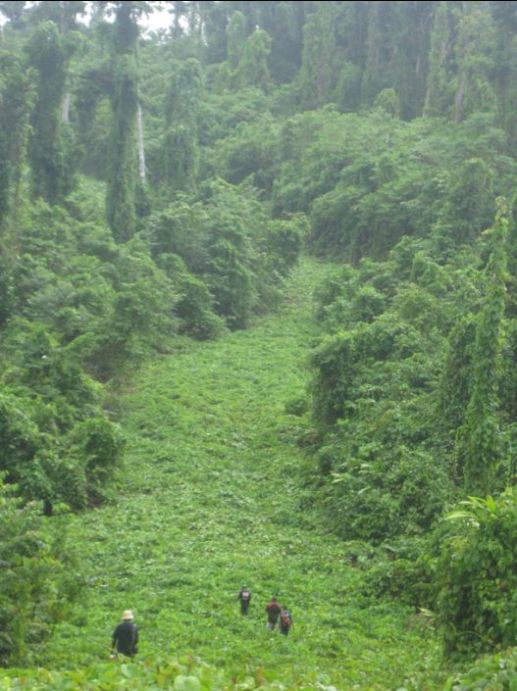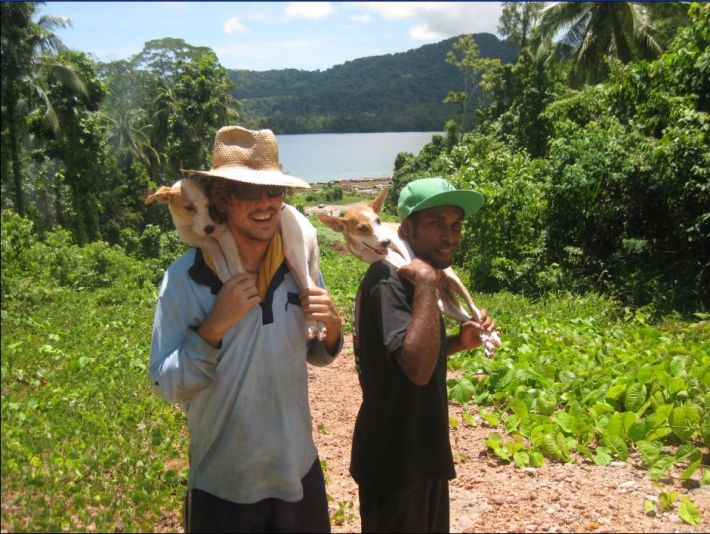Need your lawn cut? Don’t bother with flimsy and unreliable whipper-snippers or lawnmowers. Get the real deal and employ mass student labor. It is cheap and you can feel good afterwords because you’ve given the youth of today ‘character building opportunities’. Who says learning should be limited to the classroom!
Monthly Archives: March 2013
A waterfall too far
Comparing the failure of Operation Market Garden during World War 2 (A Bridge Too Far) and my failed trek through Vangunu to find the Cheara Waterfall is a little farfetched and possibly insulting to some. These two events, however, share some small similarities.
Similarity 1. Overly ambitious expectations
In WW2, the Allied attempt to break through German lines and simultaneously seize several bridges in occupied Netherlands proved to be in hindsight a tad rushed.
Similarly, my plan to paddle to the mouth of the Cheara River and walk to the middle of Vangunu Island following the disused logging road was also ill thought out. It probably didn’t help that I left at 12:30, which was very late and at the hottest part of the day.
Similarity 2. Incorrect intelligence
In September 1944, the Allied advance was being slowed by its overextended supply lines. There was also a great pressure to end the war quickly. When part of the Dutch underground reported that the Germans in the Netherlands had few resources in men or equipment and their morale was very poor, Bernard Montgomery devised a plan to drop 35,000 men behind enemy lines. What good old Monty didn’t count on was that a whole division of German SS infantry would be in Arnhem, reportedly taking a holiday.
My failed intelligence was admittedly not as extreme or life threatening, but it did nevertheless cause me a lot of trouble. Most Solomon Islanders don’t wear watches or do much travelling that is measured in the metric system. As a result, their knowledge of time and distance can be arbitrary at best. I should have known better, but when I asked a local how far it was to the local waterfall, he told me confidently that by following the logging road it was a six kilometre walk that would take me roughly one hour. Even discounting the local’s incorrect perception of time and distance, the biggest failure in intelligence was my assumption that the logging roads would be easy enough to traverse. This was not the case, as it turned out that the logging roads hadn’t been used in 10 years. In the Marovo, a lot can grow in 10 years.
Similarity 3: Inadequate equipment and support
Without going into too much detail, much of the support intended for the Allied paratroopers either didn’t arrive or were shot up in ambushes. When the radio sets were made redundant, the Germans closed in on the isolated paratroopers at the Bridge. After days of house-to-house fighting in Arnhem, the paratroopers, pitted against crack SS infantry and panzers, were either killed, captured or forced to withdraw, whilst the city was indiscriminately razed to the ground.
I had the sense at least to travel with some other people, but they were typical Isabellians and trotted off, completely leaving me stranded with the dogs. Taking along Kipper and her three puppies was a major mistake. Not only were the dogs ungrateful to be included on this grand adventure, but they were completely useless. The puppies ran out of steam within an hour of the hike and needed to be carried. Kipper also got horribly lost on many occasions when chasing wild pigs. The worst part was that the dogs complained and wined the whole way, killing morale.
Result
Operation Market Garden failed abysmally. Only a few thousand paratroopers escaped and the remainder were forced to stay behind and give themselves up. It is rumored that British Lieutenant-General Frederick Browning told good old Monty (who you can tell I don’t like) before the operation that “I think we may be going a bridge too far.” Famous last words indeed.
As for me, well a supposedly leisurely one hour stroll in the Vangunu rainforest turned into a 12 hour bush and river bash. The undergrowth was so heavy that my sandals were torn to shreds and I was forced to go barefoot. Things got even more difficult when I reached the river itself, as the recent rain had caused minor flooding. I stumbled and scampered my way up river, but decided to pull the plug when at 4:30 I had to consider ‘the Everest factor’ (the trip back). I returned to my house at 10 in the evening, cut, bruised and utterly exhausted without ever reaching that bloody waterfall.
Back in Patukae, people got a lot of laughs out of my abject failure to find the waterfall ‘that was only one hour away’. If asked again to go back to the magical Cheara Waterfall, my answer will be ‘f*** the waterfall’.
Creatively cooking with fire
In the Marovo, only the professional fishermen or tourist resorts have access to fridges or ice. As an alternative, the people here have developed ways to preserve food by using fire.
The first method is via ‘the motu’, which if translated means roughly oven. This is the predominant method of cooking for Melanesian and Polynesian cultures. It comprises of making a strong fire on heat conducting stones for a few hours. The food itself can vary greatly from fish, pig and chicken to root vegetables or pudding. Generally what tends to happen is food is wrapped together into packages with banana leaves and marinated with coconut cream. After the stones are well and truly red hot, food packages are buried for a few hours. This type of cooking tends to dry food out significantly and is therefore ideal for prolonging the ‘Solomon expiry date’. Even though motu cooked food does take a little getting used to, it definitely beats getting food poisoning.

If you put the wrong type of stones on the fire, they tend to explode when they get too hot. This is a good practice joke people play on each other.
More equipped kitchens in the Solomon Islands will have their own 40 gallon ‘drum oven’. Most drum cooked food tastes quite similar to motu cooked food. The only difference lies with the mechanics of storing heat. A fire is used in both cases, but instead of heating stones, it heats the drum itself. Drum cooking can also be more easily monitored and controlled. With constant low heat, it can serve the same function as a fridge in storing fish and meat for well over two weeks. It is also good for baking cakes and bread. Although the bread I cook could be able substitutes for sinker lead, my cakes go quite well.
The last type of cooking that uses fire, excluding frying and boiling, is smoking food. In this type of cooking, the smoke is more important than the fire. This method is more suited to when people go camping because it doesn’t need much to make it work and finding dry firewood, suitable stones or a spare 40 gallon drum can be difficult when you are in the middle of nowhere. I have learnt that it works best if you have a fair gap between the fire and the stand.











